Can You Distinguish the Masqueraders From the True Culprits?
A 60-year-old laboratory technician complained of a pruritic rash on and around her left ear. It had appeared a few days earlier, shortly after she cleaned her telephone receiver with a disinfectant. A tentative diagnosis of contact dermatitis was made, and treatment with a hydrocortisone cream was initiated.
Pruritic rash
A 60-year-old laboratory technician complained of a pruritic rash on and around her left ear. It had appeared a few days earlier, shortly after she cleaned her telephone receiver with a disinfectant. A tentative diagnosis of contact dermatitis was made, and treatment with a hydrocortisone cream was initiated.
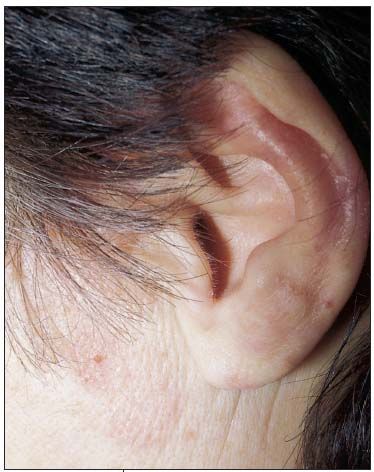
The patient returned a week later, at which time this photograph was taken. There had been no change in the appearance of the rash.
What other cause might you consider?
Answer on Next page
Answer: Tinea incognito

Since the patient mentioned that she had chronic tinea pedis, a fungal infection was suspected. Scrapings from the rash revealed long, branching hyphae, and culture on dermatophyte test medium confirmed the presence of a dermatophyte. This is a typical case of tinea incognito, and it proves that not every itchy rash responds to topical corticosteroids.
(Case and photograph courtesy of Drs Yelva Lynfield and Jennifer Goldwasser.)
Dark lesion
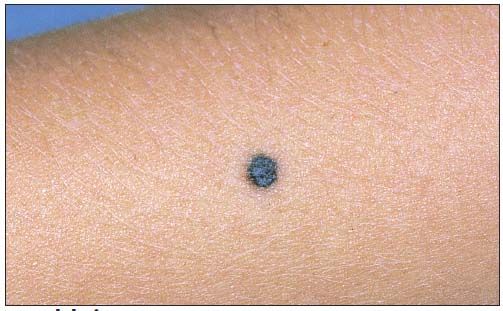
This lesion looks suspiciously like a malignant melanoma.
What else might it be?
Answer on Next page
Answer: Blue nevus

This is a blue nevus (dermal melanocytoma). This lesion can mimic a melanoma in appearance because of its dark color, but it is benign. Blue nevi are usually present from childhood, although they sometimes emerge in later life.
(Case and photograph courtesy of Dr William F. Keenan Jr.)
Rapidly growing, painless lesions
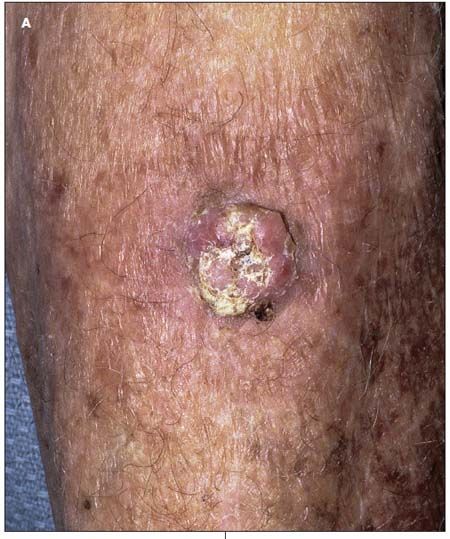
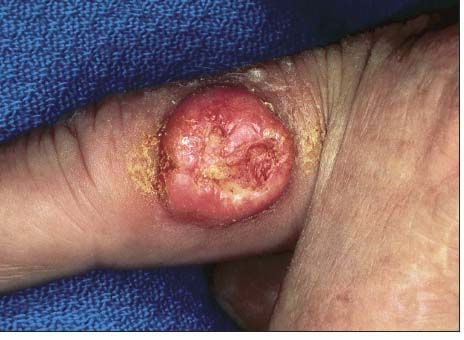
A papular lesion developed rapidly during the previous 11 days on the left forearm of an 89-year-old man (top). Another patient noticed a similar growth that developed over a 3-week period on his finger (bottom).
Are these squamous cell carcinomas or another type of lesion?
Answer on Next PageAnswer: Keratoacanthomas


These are keratoacanthomas, benign neoplasms that occur predominantly on the extensor surfaces of hands and forearms of white men older than 50 years. Because these lesions are grossly indistinguishable from squamous cell carcinoma, microscopic diagnosis is mandatory.
Spontaneous regression occurs, but a disfiguring scar may ensue. Surgical excision or electrodessication with curettage is recommended.
(Case and photograph A courtesy of Dr Robert P. Blereau; case and photograph B courtesy of Dr Daniel L. Savitt.)
Sudden muscular weakness
Sudden weakness in her right arm sent a 75-year-old woman to the emergency department. A diagnosis of possible cerebrovascular accident or transient ischemic attack was made.

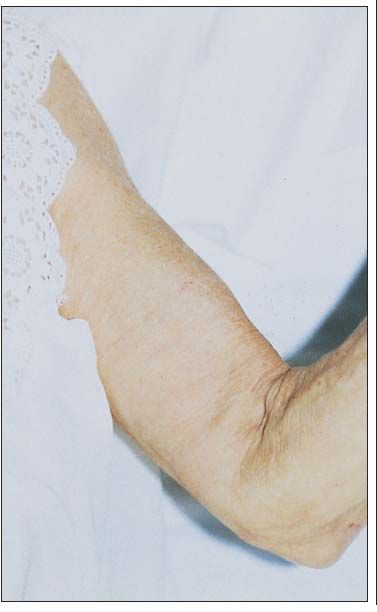
Does a comparison of the 2 arms suggest that another condition might be involved?
Answer on Next Page
Answer: Rupture of the biceps muscle


A comparison of the photographs shows that the right biceps appears to be in a “ball” (top) that is lower on the humerus than the biceps of the normal left arm (bottom). This is compatible with a diagnosis of a rupture of the biceps muscle, which, surprisingly, may not be particularly severe or painful in elderly persons.
Typically, as in this patient, preexisting degeneration of the long head of the biceps muscle weakens it sufficiently to rupture when the person tries to lift a heavy object. In such a patient, therapy is often conservative and no repair is undertaken. However, repair is indicated in younger patients, particularly athletes or those who require strong elbow flexion for their work.
(Case and photographs courtesy of Dr William F. Keenan Jr.)